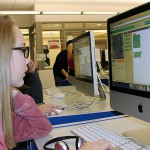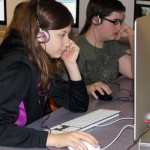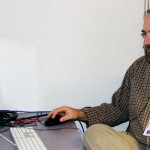Students learn computer programming
By Angie Landsverk
Students in Waupaca were among the millions from throughout the world who tried coding when they took part in last week’s Hour of Code.
“The Hour of Code is a global push to look at coding and the language of Internet, which is integral to everything we do today,” said Ben Rayome, the principal of Waupaca Middle School.
The goal of getting students to try an hour of coding took place during the week of Dec. 7, which was Computer Science Education Week.
The nonprofit Code.org helped organize events, and it also advocates for expanding access to computer science.
In the Waupaca School District, students and teachers at the middle school and Waupaca Learning Center participated at various times throughout that week. The teachers chose the time which best fit their schedules.
It was the third year the middle school did so and the first year the elementary school did.
In addition, the Waupaca Area Public Library offered opportunities for community members of all ages to code in celebration of Computer Science Education Week.
Since the Hour of Code began in 2012, its push has been to increase access to computer science, particularly for girls and middle school students, said Joan Holman, the technology integrator at WMS.
“Why am I interested in you learning about coding?” she asked a classroom of eighth graders before they headed to a computer lab.
One student mentioned technology and how it continues to expand.
“My goal is that by the time you exit high school, you are all able to code,” Holman told the students. “Developing apps is actually easier than you think.”
The elementary students coded with “The Foos” while the middle school students began with a Star Wars themed adventure and then had more coding options, she said.
Eighth grader Asher Wright said he is not really a “computer guy.” He likes to be outdoors and do hands-on activities.
His favorite classes are social studies and technology education, and he excels in math.
However. once he started the coding activity, he found it to be quite easy.
“They show you all the steps. You put it down. It’s pretty simple to follow,” Wright said. “It doesn’t really matter if you’re not good at computers. They have something for everyone, and it’s really simple to follow.”
Anya Harrington is also an eighth grader who participated in last week’s Hour of Code.
“It teaches you how to do it in a fun way,” she said. “It took a minute, but once I got it, it was pretty easy.”
Harrington likes math and science and said she is “open to everything” when it comes to thinking about possible fields to pursue.
Role in classroom
Joel Kempfert’s middle school classroom is much different than it was when he began teaching 18 years ago.
“Technology is the way of the future,” said the eighth-grade science teacher.
Today, he uses real time resources when he is teaching.
The United States Geological Survey website is one such example.
There his students are able to see the latest information about earthquakes in the United States.
“It’s stuff that never would have been in a textbook in the past,” he said. “The speed of education is so much faster today.”
Figuring out what resources are available to his students is his focus.
“It’s a learning process on both ends,” Kempfert said.
One of the latest projects his students are working on involves using Google Maps to upload where earthquakes and volcanoes were in the last year.
Holman is in her fourth year of being the middle school’s technology integrator, and Kempfert said she is a great resource for the teachers, keeping them on top of incorporating technology in their classrooms.
Jay Seefeldt teaches eighth-grade social studies and science and said for students, the Hour of Code is “an opportunity to be exposed and see if it’s something you’re interested in.”
He said technology is changing fast, and regardless of what profession students choose, they will encounter it.
At Waupaca High School, all students are required to take Computer Studies.
That class is a prerequisite for any of the programming classes.
“Our opportunity to get a taste of coding and programming will hopefully spark their interest in taking future classes in computer science,” Holman said.
Rayome noted there are programming jobs in need of qualified people to fill them.
“Kids are used to playing video games and to their phones and computers, but do they know how it works?” he asked.
The Hour of Code gives students a basic understanding of the programming language, Rayome said.
“It makes them think more analytically, which goes along with math and science. It can fit into all kinds of applications in their educational world as it is,” he said.
Rayome did the Hour of Code in past school years and said it is fun.
“They make it interesting. There’s something new every year,” he said. “It gets the kids engaged in their learning. It’s one of those things that reaches beyond our building. For one hour, they’re focusing and seeing what they can do.”
For additional information about computer science in schools and coding, visit www.code.org and www.hourofcode.com/us.



